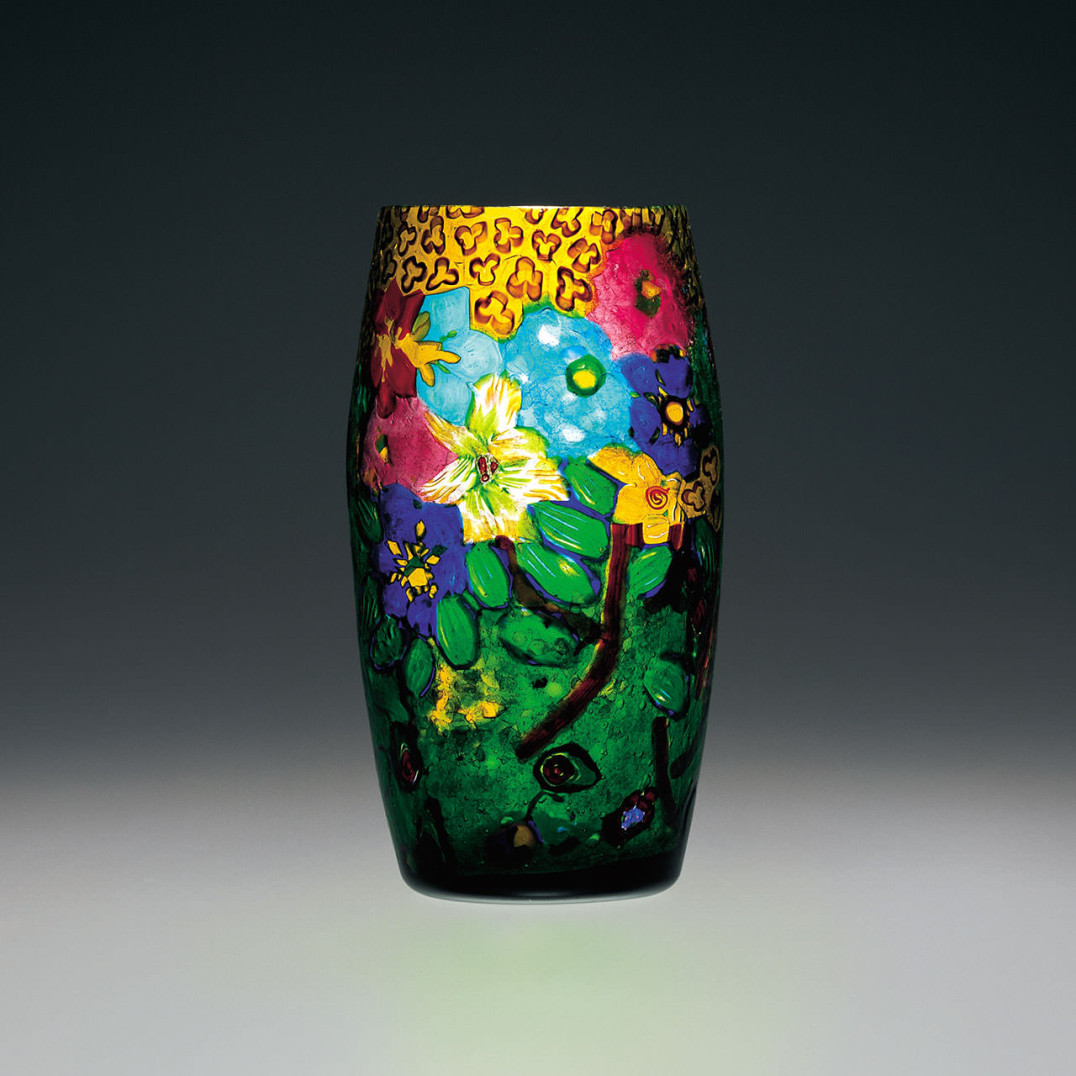
Benvenuto BarovierFloreale a murrine, 1913-1914
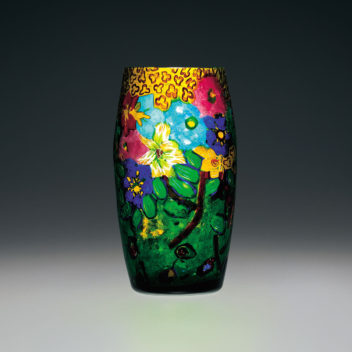
Benvenuto BarovierFloreale a murrineArtisti Barovier, 1913-1914
Vetro mosaico vase composed of multicolored patches of translucent glass tessere set to form a floral pattern. Several vases in vetro mosaico were presented by the Artisti Barovier at the Ca’ Pesaro show in 1913. At this exhibition the Artisti Barovier shared a room, dedicated exclusively to glass, with the painter Vittorio Zecchin, who also designed vessels and tiles using the murrine technique.
Signed with a glass murrina bearing the initials AB, above which rises a crown.
7 7/8 in. high (20 cm)
Exhibitions:
1913, Venice, Ca’ Pesaro
(?);
1914, Venice, 11th Biennale Internazionale d’Arte (?);
2000, New York, Venetian Glass, Museum of Arts & Design;
2001, Milan, Murano: Vetri dalla Collezione Olnick Spanu,
Spazio Oberdan.
Bibliography and comparative texts:
Catalogue of the Esposizione di Estate, 1920, p. 1;
M. Barovier, 1993, nn. 32, 48;
M. Barovier, R. Barovier Mentasti,
A. Dorigato 1995, n. 9;
M. Heiremans, 1996, n. 5;
R. Reif, New York Times, 2000, p. 39;
Olnick Spanu, 2000, n. 1;
Olnick Spanu, 2001, n. 3.
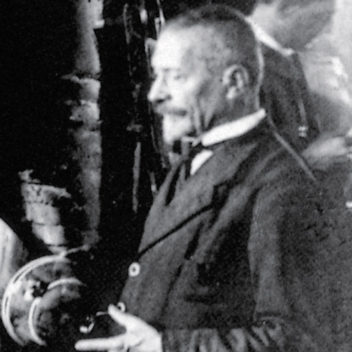
Benvenuto Barovier 1855–1932
Maestro and designer Benvenuto Barovier first worked as a glassblower for a company called Compagnia di Venezia e Murano (C.V.M.) where he was noted for his remarkable manual skills. In 1877, he and his brother Giuseppe were invited by Antonio Salviati to collaborate in his new furnace called Salviati dott. Antonio. When Salviati retired from the business of production in 1883, Benvenuto and Giuseppe bought the company where they worked as glassblowers and designers, eventually renaming it Artisti Barovier after Salviati's death in 1890. Among Benvenuto's many creations are some extraordinary pieces made in mosaico glass. Apart from the significant technical quality of these objects, one can perceive the passionate experimentation carried out by the maestro from Murano, who frequently used crushed glass to decorate his pieces. He and his brother received widespread critical acclaim at several exhibitions that took place at Cà Pesaro. After the transformation of the company into Vetreria Artistica Barovier & C. (1919), Benvenuto Barovier continued to participate actively in the furnace.
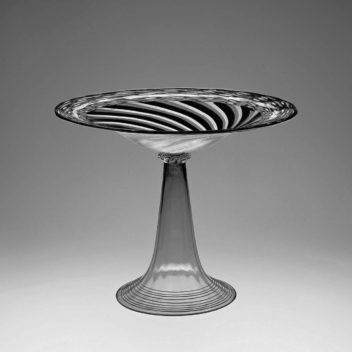
Artisti Barovier 1890–1919
Giovanni Barovier and his nephews Giuseppe, Benvenuto, and Benedetto worked as glassblowers at the Salviati dott. Antonio furnace, founded in 1877. In 1884, after Salviati's departure, they acquired ownership of the company. On the basis of an agreement signed with Salviati, the company maintained its original name until Salviati's death in 1890. It then changed its name to Artisti Barovier. Under the guidance of Benvenuto and Giuseppe, the company reproduced the classical themes of nineteenth-century glass and soon achieved fame for the refinement of its production. Works executed later, particularly a murrine, were inspired by floral themes. The Artisti Barovier took several of these pieces to different exhibitions, including the Cà Pesaro (1908, 1909, 1913), where pieces designed by Zecchin and Wolf-Ferrari were also shown. During World War I, the furnace was temporarily moved to Livorno in Tuscany. In 1919, the company name was changed to Vetreria Artistica Barovier and several new partners were added. Among them were Ercole Barovier and Nicolò Barovier, Benvenuto Barovier's sons, and Giuseppe Barovier's son Napoleone.
Benvenuto BarovierFloreale a murrine, 1913-1914
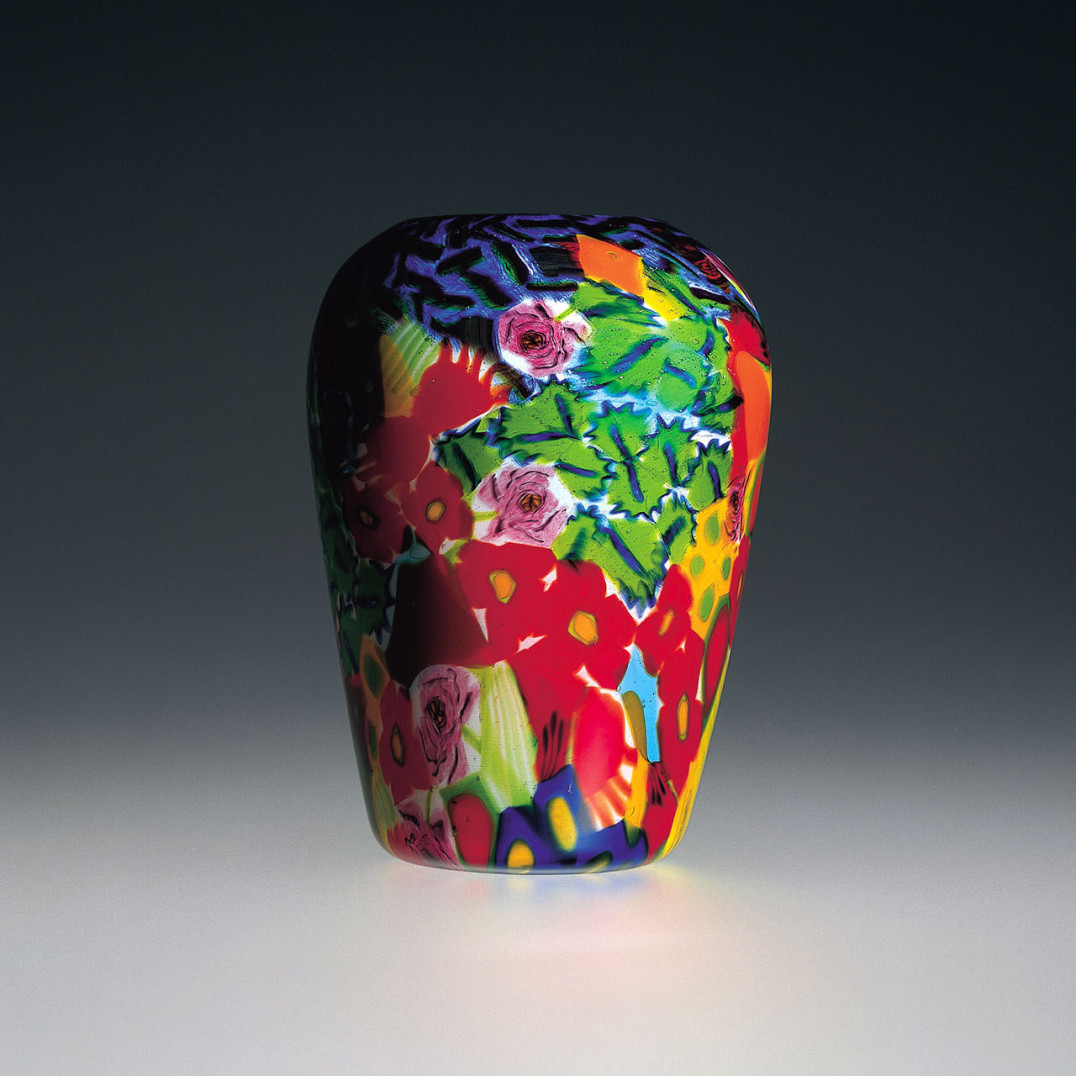
Benvenuto BarovierFloreale a murrine, ca. 1919
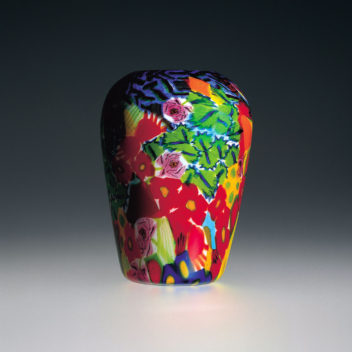
Benvenuto BarovierFloreale a murrineArtisti Barovier, ca. 1919
A vetro mosaico vase cased in lattimo glass. Crafted with multicolored patches of translucent glass tessere set to form a floral pattern.
9 3/8 in. high (23.8 cm)
Exhibitions:
2000, New York, Venetian Glass, Museum of Arts & Design;
2001, Milan, Murano: Vetri dalla Collezione Olnick Spanu, Spazio Oberdan.
Bibliography and comparative texts:
G. Lorenzetti, 1921, p. 1093;
M. Barovier, 1993, n. 55;
Olnick Spanu, 2000, n. 2;
Olnick Spanu, 2001, n. 4.

Benvenuto Barovier 1855–1932
Maestro and designer Benvenuto Barovier first worked as a glassblower for a company called Compagnia di Venezia e Murano (C.V.M.) where he was noted for his remarkable manual skills. In 1877, he and his brother Giuseppe were invited by Antonio Salviati to collaborate in his new furnace called Salviati dott. Antonio. When Salviati retired from the business of production in 1883, Benvenuto and Giuseppe bought the company where they worked as glassblowers and designers, eventually renaming it Artisti Barovier after Salviati's death in 1890. Among Benvenuto's many creations are some extraordinary pieces made in mosaico glass. Apart from the significant technical quality of these objects, one can perceive the passionate experimentation carried out by the maestro from Murano, who frequently used crushed glass to decorate his pieces. He and his brother received widespread critical acclaim at several exhibitions that took place at Cà Pesaro. After the transformation of the company into Vetreria Artistica Barovier & C. (1919), Benvenuto Barovier continued to participate actively in the furnace.

Artisti Barovier 1890–1919
Giovanni Barovier and his nephews Giuseppe, Benvenuto, and Benedetto worked as glassblowers at the Salviati dott. Antonio furnace, founded in 1877. In 1884, after Salviati's departure, they acquired ownership of the company. On the basis of an agreement signed with Salviati, the company maintained its original name until Salviati's death in 1890. It then changed its name to Artisti Barovier. Under the guidance of Benvenuto and Giuseppe, the company reproduced the classical themes of nineteenth-century glass and soon achieved fame for the refinement of its production. Works executed later, particularly a murrine, were inspired by floral themes. The Artisti Barovier took several of these pieces to different exhibitions, including the Cà Pesaro (1908, 1909, 1913), where pieces designed by Zecchin and Wolf-Ferrari were also shown. During World War I, the furnace was temporarily moved to Livorno in Tuscany. In 1919, the company name was changed to Vetreria Artistica Barovier and several new partners were added. Among them were Ercole Barovier and Nicolò Barovier, Benvenuto Barovier's sons, and Giuseppe Barovier's son Napoleone.
Benvenuto BarovierFloreale a murrine, ca. 1919
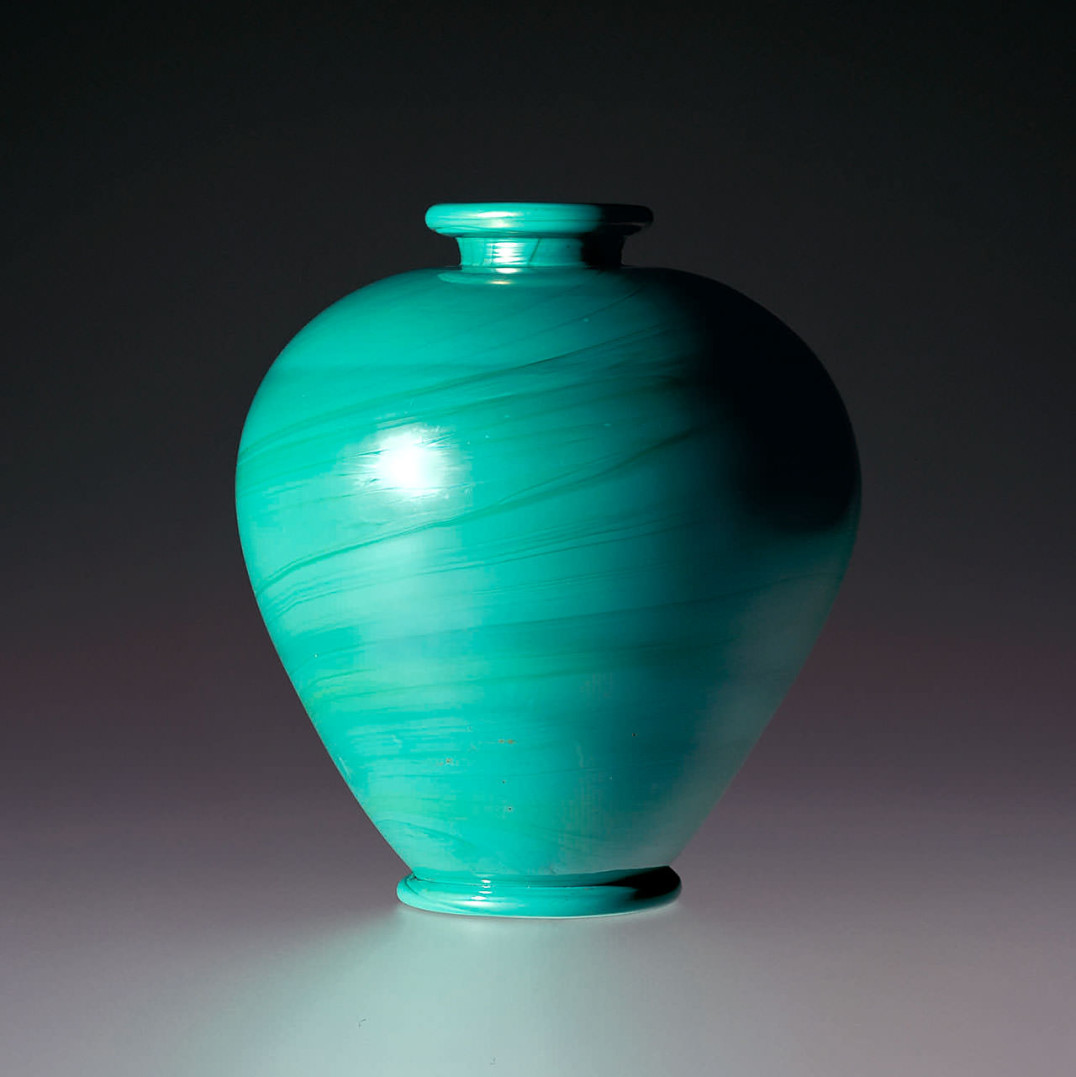
Carlo ScarpaPasta vitrea, 1929-1930
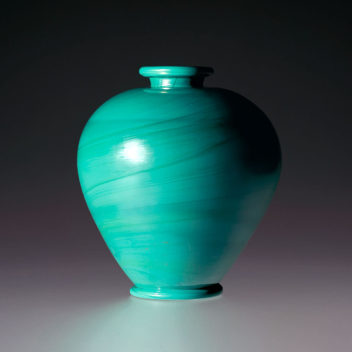
Carlo ScarpaPasta vitreaMaestri Vetrai Muranesi Cappellin & C., 1929-1930
Vase in green pasta vitrea with applications of gold leaf.
Signature etched with acid:
M.V.M. Cappellin Murano.
8 1/4 in. high (21 cm)
Exhibitions:
2001, Milan, Murano: Vetri dalla Collezione Olnick Spanu, Spazio Oberdan.
Bibliography and comparative texts:
Domus, 1930, January, p. 38;
Mostra di vetri…, 1931, pp. 22, 23;
Venezianisches Glas…, 1981, p. 64;
Murano Glass…, 1982, n. 122;
Mostra del vetro…, 1984, p. 83;
M. Karasik, 1989, n. 4;
M. Barovier, 1991, nn. 1, 2;
M. Barovier, 1997, p. 194;
M. Barovier, 1998 (a), pp. 7-9;
M. Barovier, 1999, p. 141;
Olnick Spanu, 2001, n. 41.
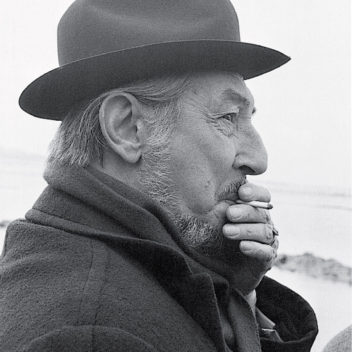
Carlo Scarpa 1906–1978
Born in Venice, Carlo Scarpa graduated from the Accademia di Belle Arti in Venice in 1926. Soon after his graduation he began work at M.V.M. Cappellin, where he soon replaced Vittorio Zecchin as artistic director. Following the direction laid down by Zecchin, he initially created transparent blown-glass pieces with essential forms, in particular the pieces exemplified by their conic base. Scarpa later designed light glass pieces in brightly colored pasta vitrea, or decorated fenici. Deservedly famous was the refined collection of lattimi decorated with gold or silver leaf, which he presented for the first time in Monza in 1930 together with the canne verticali and millefiori glass works. Giacomo Cappellin closed the workshop in 1932 for bankruptcy, putting an end to the collaboration with Carlo Scarpa. In 1934, Scarpa became the artistic director of Venini & C., where he continued to work through 1947. Alongside Paolo Venini, who often participated in the design of glass, Carlo Scarpa experimented with the vast potential of glass, using and innovating many traditional techniques, by which he created extraordinary modern pieces. After the mezza filigrana glass works came the sommersi, the pasta vitrea inspired by Chinese ceramic motifs, the corrosi, the battuti, the vessels a fasce colorate, a pennellate, the variegati, and the famous multicolored murrine with the surfaces finished at the carving wheel. After World War II, Carlo Scarpa worked almost exclusively as an architect and teacher.
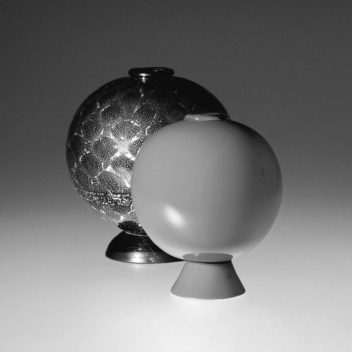
Maestri Vetrai Muranesi Cappellin & C. 1925–1932
M.V.M. Cappellin & C. was founded in 1925 by Giacomo Cappellin after the closing of Cappellin Venini & C. Vittorio Zecchin, a painter from Murano who had worked for Cappellin Venini, continued his collaboration with Cappellin for a short time, designing soffiati, blown glass pieces characterized by delicate colors and pure lines. At the end of 1926, following Zecchin's departure, the young Carlo Scarpa took over the artistic direction of the company. Initially, he proceeded along the course taken by his predecessor, creating lightweight blown pieces with simple geometric forms. These were followed by many collections of refined elegance characterized by various transparent textures and often distinguished by vivid colors. Despite the remarkable success at the 1930 Biennale di Monza, M.V.M. Cappellin & C. was forced to close in January 1932. This was most likely the result of inefficient financial management.
Carlo ScarpaPasta vitrea, 1929-1930
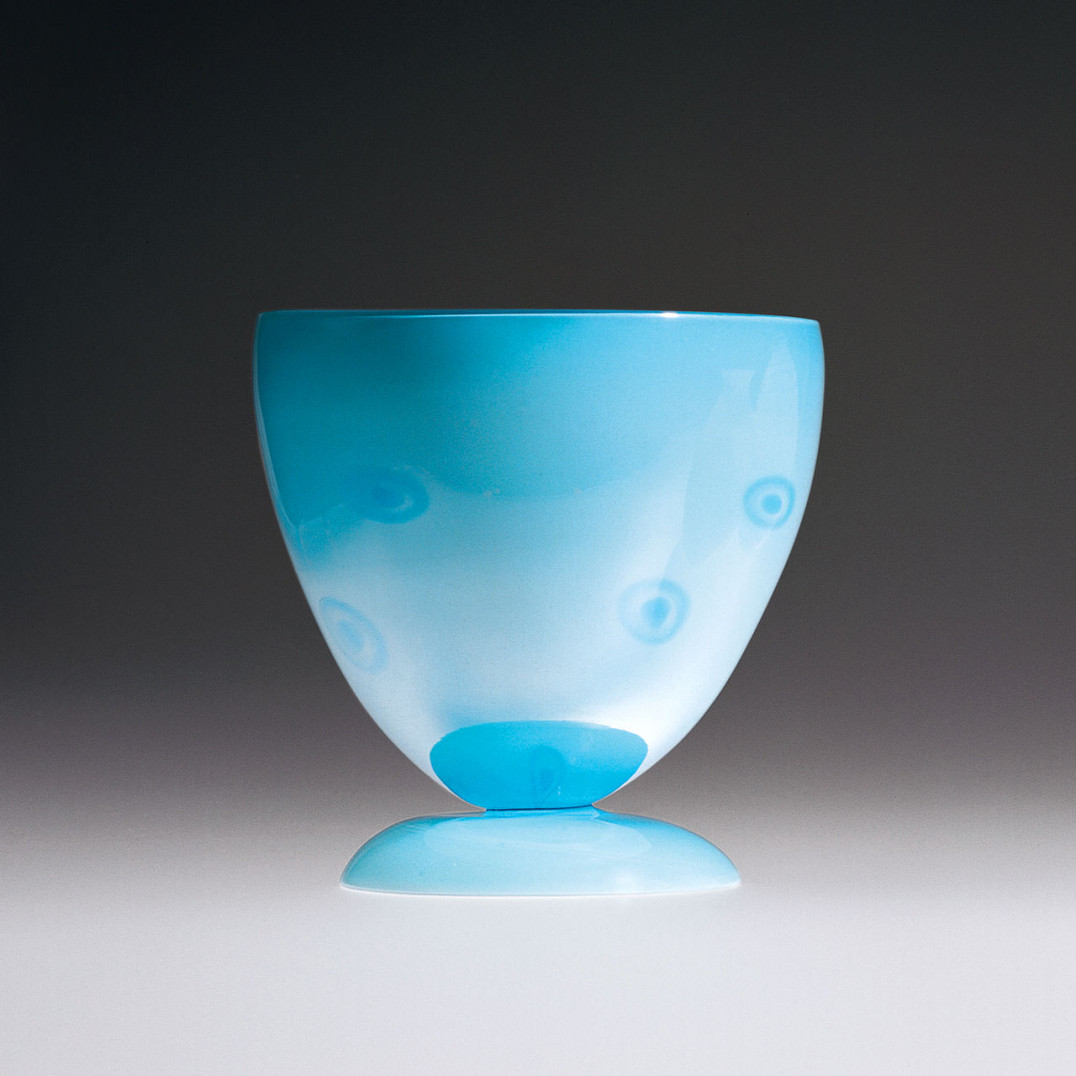
Carlo ScarpaMillefiori, 1930-1931
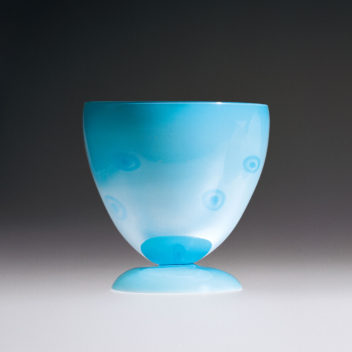
Carlo ScarpaMillefioriMaestri Vetrai Muranesi Cappellin & C., 1930-1931
Millefiori footed bowl cased in light blue lattimo glass with inclusions of circular light blue murrine.
Acid stamped: M.V.M. Cappellin Murano.
8 1/4 in. high (21 cm)
Exhibitions:
1930, Monza, 4th Esposizione Internazionale delle Arti Decorative
e Industriali Moderne;
1931, Amsterdam, Exhibition of modern Italian glass, ceramic, and artistic lacework, Stedelijk Museum;
2000, New York, Venetian Glass, Museum of Arts & Design;
2001, Milan, Murano: Vetri dalla Collezione Olnick Spanu, Spazio Oberdan.
Bibliography and comparative texts:
Millefiori: M.V.M. Catalogue, n. 5821;
C.A. Felice 1930, n. 12;
Mostra di vetri…, 1931, p. 25;
M. Barovier, 1991, n. 10;
R. Barovier Mentasti, 1992, n. 66;
L’arte del vetro…, 1992, p. 241;
M. Heiremans, 1993, n. 87;
F. Deboni, 1996 n. 67;
M. Heiremans, 1996, n. 36;
M. Barovier, 1997, pp. 200, 201;
M. Barovier, 1998 (b), p. 14;
M. Barovier, 1999, p. 141;
Olnick Spanu, 2000, n. 26;
Olnick Spanu, 2001, n. 42.

Carlo Scarpa 1906–1978
Born in Venice, Carlo Scarpa graduated from the Accademia di Belle Arti in Venice in 1926. Soon after his graduation he began work at M.V.M. Cappellin, where he soon replaced Vittorio Zecchin as artistic director. Following the direction laid down by Zecchin, he initially created transparent blown-glass pieces with essential forms, in particular the pieces exemplified by their conic base. Scarpa later designed light glass pieces in brightly colored pasta vitrea, or decorated fenici. Deservedly famous was the refined collection of lattimi decorated with gold or silver leaf, which he presented for the first time in Monza in 1930 together with the canne verticali and millefiori glass works. Giacomo Cappellin closed the workshop in 1932 for bankruptcy, putting an end to the collaboration with Carlo Scarpa. In 1934, Scarpa became the artistic director of Venini & C., where he continued to work through 1947. Alongside Paolo Venini, who often participated in the design of glass, Carlo Scarpa experimented with the vast potential of glass, using and innovating many traditional techniques, by which he created extraordinary modern pieces. After the mezza filigrana glass works came the sommersi, the pasta vitrea inspired by Chinese ceramic motifs, the corrosi, the battuti, the vessels a fasce colorate, a pennellate, the variegati, and the famous multicolored murrine with the surfaces finished at the carving wheel. After World War II, Carlo Scarpa worked almost exclusively as an architect and teacher.

Maestri Vetrai Muranesi Cappellin & C. 1925–1932
M.V.M. Cappellin & C. was founded in 1925 by Giacomo Cappellin after the closing of Cappellin Venini & C. Vittorio Zecchin, a painter from Murano who had worked for Cappellin Venini, continued his collaboration with Cappellin for a short time, designing soffiati, blown glass pieces characterized by delicate colors and pure lines. At the end of 1926, following Zecchin's departure, the young Carlo Scarpa took over the artistic direction of the company. Initially, he proceeded along the course taken by his predecessor, creating lightweight blown pieces with simple geometric forms. These were followed by many collections of refined elegance characterized by various transparent textures and often distinguished by vivid colors. Despite the remarkable success at the 1930 Biennale di Monza, M.V.M. Cappellin & C. was forced to close in January 1932. This was most likely the result of inefficient financial management.
Carlo ScarpaMillefiori, 1930-1931
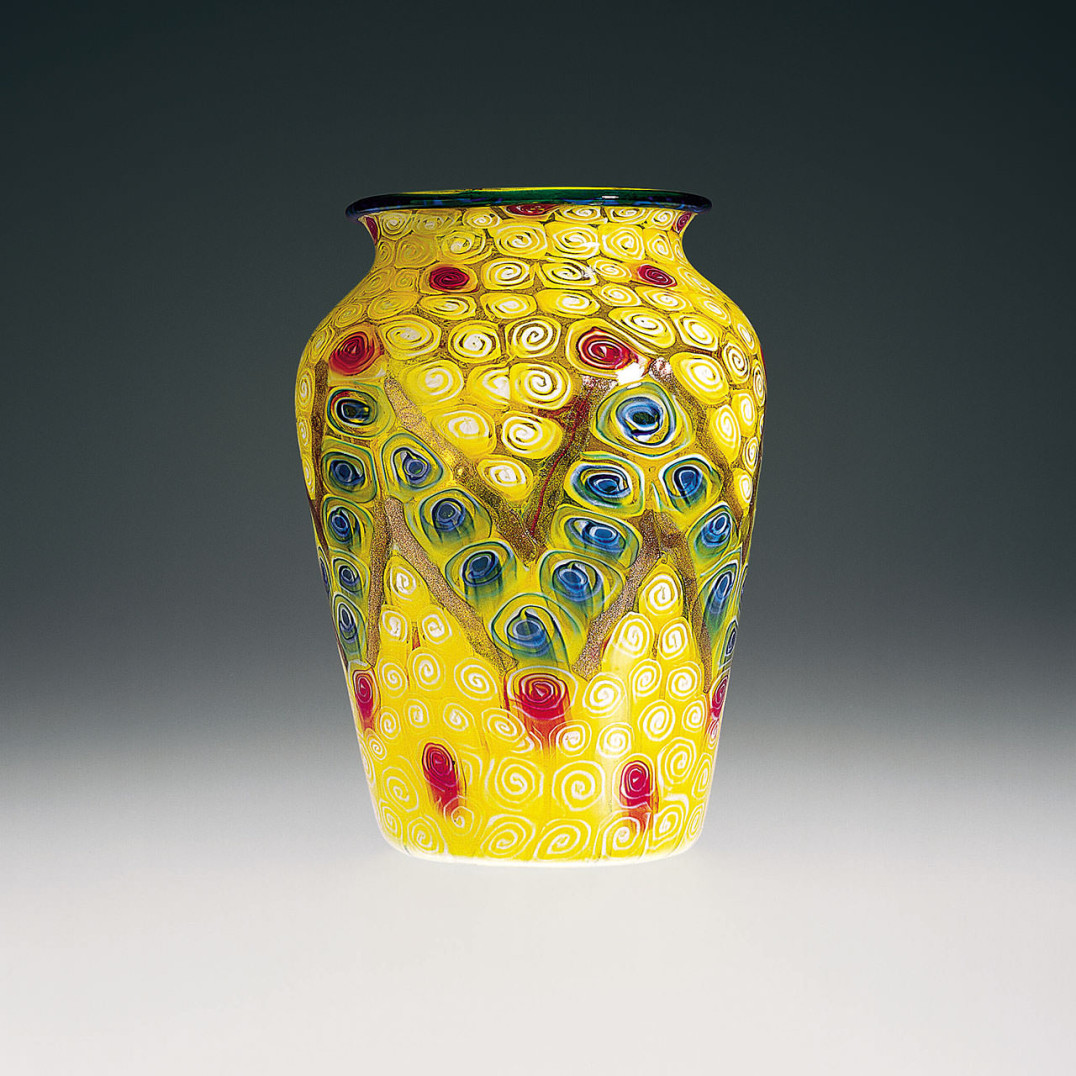
Giuseppe BarovierA murrine, ca. 1919
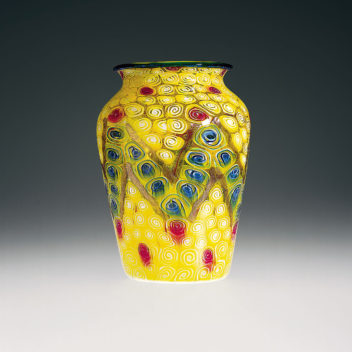
Giuseppe BarovierA murrineArtisti Barovier, ca. 1919
A vetro mosaico vase crafted with spiraling white and yellow, and white and red murrine. The central part is decorated with a stripe ofavventurina glass, creating a greca pattern with the use of white and blue murrine.
Signed with a glass murrina bearing the initials AB, above which rises a crown.
11 7/16 in. high (29 cm)
Exhibitions:
2000, New York, Venetian Glass, Museum of Arts & Design;
2001, Milan, Murano: Vetri dalla Collezione Olnick Spanu, Spazio Oberdan.
Bibliography and comparative texts:
R. Barovier Mentasti, 1992, n. 38;
M. Barovier, 1993, n. 50;
M. Barovier, 1994, n. 1;
M. Barovier, 1999, p. 93;
Olnick Spanu, 2000, n. 3;
Olnick Spanu, 2001, n. 5.
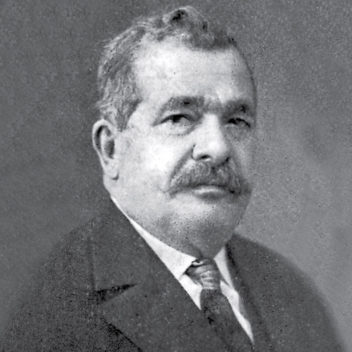
Giuseppe Barovier 1853–1942
Giuseppe Barovier went to work at the Compagnia di Venezia e Murano at a very young age and soon, due to his exceptional skills, became a maestro. He distinguished himself in various fields, from the decoration of blown pieces to the execution of murrine glass to chandeliers. In 1877, he left the Compagnia di Venezia e Murano to follow Antonio Salviati to his new glass workshop called Salviati dott. Antonio, where he worked with his brother, Benvenuto. After the Baroviers took over the ownership of the furnace in 1883, renaming it Artisti Barovier in 1890, Giuseppe became maestro and designer with his brother. Among his many creations that deserve mention are his refined murrine, which the Artisti Barovier presented at the Cà Pesaro exhibitions. When Artisti Barovier was liquidated in 1919, he, his brother Benvenuto, and their sons founded the Vetreria Artistica Barovier & C., where he worked until the end of the ‘20s.

Artisti Barovier 1890–1919
Giovanni Barovier and his nephews Giuseppe, Benvenuto, and Benedetto worked as glassblowers at the Salviati dott. Antonio furnace, founded in 1877. In 1884, after Salviati's departure, they acquired ownership of the company. On the basis of an agreement signed with Salviati, the company maintained its original name until Salviati's death in 1890. It then changed its name to Artisti Barovier. Under the guidance of Benvenuto and Giuseppe, the company reproduced the classical themes of nineteenth-century glass and soon achieved fame for the refinement of its production. Works executed later, particularly a murrine, were inspired by floral themes. The Artisti Barovier took several of these pieces to different exhibitions, including the Cà Pesaro (1908, 1909, 1913), where pieces designed by Zecchin and Wolf-Ferrari were also shown. During World War I, the furnace was temporarily moved to Livorno in Tuscany. In 1919, the company name was changed to Vetreria Artistica Barovier and several new partners were added. Among them were Ercole Barovier and Nicolò Barovier, Benvenuto Barovier's sons, and Giuseppe Barovier's son Napoleone.